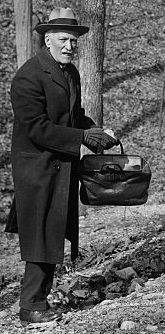Walter Hough: Difference between revisions
Appearance
Content deleted Content added
No edit summary |
No edit summary |
||
| Line 27: | Line 27: | ||
==References== |
==References== |
||
| ⚫ | |||
<references /> |
<references /> |
||
==External links== |
|||
| ⚫ | |||
*[http://onlinelibrary.wiley.com/doi/10.1525/aa.1936.38.3.02a00110/pdf "Walter Hough: An Appreciation"], ''American Anthropologist'', Volume 38, Issue 3, |
|||
*Christy G. Turner, II and Jacqueline A. Turner, [http://www.jstor.org/discover/10.2307/280828?uid=3739936&uid=2129&uid=2&uid=70&uid=4&uid=3739256&sid=21102251988141 "The First Claim for Cannibalism in the Southwest: Walter Hough's 1901 Discovery at Canyon Butte Ruin 3, Northeastern Arizona"], ''American Antiquity'', Vol. 57, No. 4 (Oct., 1992), pp. 661-682 |
|||
{{Authority control|VIAF=5039321}} |
{{Authority control|VIAF=5039321}} |
||
Revision as of 19:35, 23 May 2013
This article needs additional citations for verification. (December 2009) |

Walter Hough, Ph.D. (1859–1935) was an American ethnologist, born at Morgantown, W. Va.
Leben
He was educated at Monongalia Academy, West Virginia Agricultural College, and West Virginia University (A.B., 1883; Ph.D., 1894). He was employed at the United States National Museum as an assistant (1886–94), as assistant curator of ethnology (1896–1910), and as curator after 1910.

In 1892 he was made Knight of the Order of Isabella when in Madrid as a member of the United States Commission. He was a member of Dr. J. Walter Fewkes expedition to Arizona (1896–97), went to Mexico, and explored areas of the Southwest.
Publications
- "Censers and incense of Mexico and Central America"—full online copy at HathiTrust[1]
References
- ^ Hough, Walter (1912), "Censers and incense of Mexico and Central America", Proceedings of the United States National Museum, vol. 42, Washington: Smithsonian Institution Press (etc.) (published 7 April 1912), pp. 109–137, ISSN 0096-3801, retrieved 16 April 2010
{{citation}}: Invalid|ref=harv(help)
External links
- "Walter Hough: An Appreciation", American Anthropologist, Volume 38, Issue 3,
- Christy G. Turner, II and Jacqueline A. Turner, "The First Claim for Cannibalism in the Southwest: Walter Hough's 1901 Discovery at Canyon Butte Ruin 3, Northeastern Arizona", American Antiquity, Vol. 57, No. 4 (Oct., 1992), pp. 661-682
